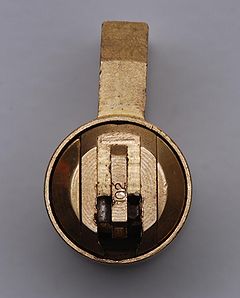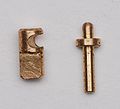BiLock EX: Difference between revisions
No edit summary |
No edit summary |
||
| Line 14: | Line 14: | ||
The '''BiLock EX''' (or '''BiLock NG''', '''BiLock New Generation''') is a dual-[[sidebar]] lock made by [[Australian Lock Company]]. The BiLock EX uses twelve pins arranged in two rows of six. Each row of pins uses a separate sidebar located at 3 and 9 o'clock in the plug. It also uses a moving element in the key blade which is used to position an addition component at the front of the plug. The BiLock EX is easily identified by the U-shaped key and keyway. | The '''BiLock EX''' (or '''BiLock NG''', '''BiLock New Generation''') is a dual-[[sidebar]] lock made by [[Australian Lock Company]]. The BiLock EX uses twelve pins arranged in two rows of six. Each row of pins uses a separate sidebar located at 3 and 9 o'clock in the plug. It also uses a moving element in the key blade which is used to position an addition component at the front of the plug. The BiLock EX is easily identified by the U-shaped key and keyway. | ||
The BiLock EX supercedes the earlier [[BiLock]] design | The BiLock EX supercedes the earlier [[BiLock]] design and is available in the [[BiLock QC]] interchangeable core format. | ||
__TOC__ | __TOC__ | ||
| Line 21: | Line 21: | ||
== Principles of operation == | == Principles of operation == | ||
The BiLock EX/NG uses a total of twelve pins arranged in two rows of six. Each row of pins interacts with a [[sidebar]] on each side of the plug. Each pin has a round hole, the true gate, and a false gate located two pin depths away from the true gate. The false gate is the same shape as the true gate, but is too shallow to allow the sidebar to fully retract. To open the lock, all pins are raised and the side bar legs retract into the true gate on each pin. There are 4 depths for pins, which allows 16,777,216 (4<sup>12</sup>) theoretical key [[differs]]. [[Master keying]] is available by using pins with wider sidebar holes. Master keyed pins do not use false gates. | |||
The main difference between the classic [[BiLock]] and the BiLock EX is a moving element in the key. Similar to the component used in the [[Mul-T-Lock Interactive]], this component in the key interacts with a movable element at the front of the lock, referred to as the "13th locking dimension" by BiLock advertising literature.<ref>Australian Lock Company. [http://www.australianlock.com.au/system/files//f6/f1/o586/BiLockNewGenDLBrochure_1.pdf BiLock Sales Brochure]</ref> While at rest, the movable element connects to a blocking bar that prevents the sidebar at 3 o'clock from retracting. The moving element in the key raises the blocking bar so that the sidebar may retract. Unlike other interactive components, the BiLock's component does not use a shear line or other positive locking mechanism; it only needs to be moved up to function. | |||
The EX/NG plug also has a removable faceplate which allows the warding of the lock to be changed without replacement of the plug or cylinder. The actual design of EX/NG keys slightly differs from previous models; the base of the key and keyway are curved inward.<ref>{{Ref pulford}}</ref> | |||
<div align="center"><gallery> | <div align="center"><gallery> | ||
File:BiLock NG key.jpg|The BiLock EX key. | |||
File:BiLock NG pins.jpg|Pins used in the EX, with false gates and master keyed pin shown. | |||
File:BiLock NG sidebar.jpg|One of the sidebars used in the EX. | |||
File:BiLock NG floating.jpg|Moving element pin and blocking bar. | |||
</gallery></div> | </gallery></div> | ||
'''Notes''' | '''Notes''' | ||
* BiLock keys are cut then folded to create their U-shape. | * BiLock keys are cut then folded to create their U-shape. | ||
* The BiLock EX/NG core is compatible with the [[BiLock]] and [[BiLock QC]] cylinders. | |||
== Disassembly instructions == | == Disassembly instructions == | ||
| Line 41: | Line 44: | ||
# Remove the [[cam]] or C-clip. | # Remove the [[cam]] or C-clip. | ||
# Remove the [[plug]] from the cylinder. A [[plug follower]] is not needed because there are no driver pins. | # Remove the [[plug]] from the cylinder. A [[plug follower]] is not needed because there are no driver pins. | ||
# Remove the faceplate from the front of the | # Remove the faceplate from the front of the plug to access the moving element and the pin chamber cover. | ||
== Vulnerabilities == | == Vulnerabilities == | ||
| Line 57: | Line 60: | ||
<div align="center"><gallery> | <div align="center"><gallery> | ||
File:BiLock NG floating.jpg | File:BiLock NG floating normal.jpg|Moving component (key) in the default position. | ||
File:BiLock NG floating engaged.jpg | File:BiLock NG floating engaged.jpg|Moving component (key) in the active position. | ||
File:BiLock NG key bitting.jpg|Closeup of the key bitting. | |||
File:BiLock NG key.jpg | |||
</gallery></div> | </gallery></div> | ||
| Line 72: | Line 71: | ||
* [[Australian Lock Company]] | * [[Australian Lock Company]] | ||
* [[BiLock]] | |||
* [[Sidebar]] | * [[Sidebar]] | ||
[[Category:Australian Lock Company|BiLock EX]] | [[Category:Australian Lock Company|BiLock EX]] | ||
[[Category:Sidebar locks]] | [[Category:Sidebar locks]] | ||
Revision as of 21:35, 25 May 2010
BiLock EX/NG
| BiLock EX/NG | |
 | |
| Name | BiLock EX/NG |
|---|---|
| Manufacturer | Australian Lock Company |
| Lock Type | Cylinder |
| Lock Design | Sidebar |
| Year(s) Produced | 1998 - present |
| Patent | US 6,681,609 |
| Related Locks | |
| BiLock BiLock QC | |
The BiLock EX (or BiLock NG, BiLock New Generation) is a dual-sidebar lock made by Australian Lock Company. The BiLock EX uses twelve pins arranged in two rows of six. Each row of pins uses a separate sidebar located at 3 and 9 o'clock in the plug. It also uses a moving element in the key blade which is used to position an addition component at the front of the plug. The BiLock EX is easily identified by the U-shaped key and keyway.
The BiLock EX supercedes the earlier BiLock design and is available in the BiLock QC interchangeable core format.
Principles of operation
The BiLock EX/NG uses a total of twelve pins arranged in two rows of six. Each row of pins interacts with a sidebar on each side of the plug. Each pin has a round hole, the true gate, and a false gate located two pin depths away from the true gate. The false gate is the same shape as the true gate, but is too shallow to allow the sidebar to fully retract. To open the lock, all pins are raised and the side bar legs retract into the true gate on each pin. There are 4 depths for pins, which allows 16,777,216 (412) theoretical key differs. Master keying is available by using pins with wider sidebar holes. Master keyed pins do not use false gates.
The main difference between the classic BiLock and the BiLock EX is a moving element in the key. Similar to the component used in the Mul-T-Lock Interactive, this component in the key interacts with a movable element at the front of the lock, referred to as the "13th locking dimension" by BiLock advertising literature.[1] While at rest, the movable element connects to a blocking bar that prevents the sidebar at 3 o'clock from retracting. The moving element in the key raises the blocking bar so that the sidebar may retract. Unlike other interactive components, the BiLock's component does not use a shear line or other positive locking mechanism; it only needs to be moved up to function.
The EX/NG plug also has a removable faceplate which allows the warding of the lock to be changed without replacement of the plug or cylinder. The actual design of EX/NG keys slightly differs from previous models; the base of the key and keyway are curved inward.[2]
Notes
- BiLock keys are cut then folded to create their U-shape.
- The BiLock EX/NG core is compatible with the BiLock and BiLock QC cylinders.
Disassembly instructions
The BiLock EX is easy to disassemble, but the moving element uses a number of small components that need to be considered.
- Remove the cam or C-clip.
- Remove the plug from the cylinder. A plug follower is not needed because there are no driver pins.
- Remove the faceplate from the front of the plug to access the moving element and the pin chamber cover.
Vulnerabilities
The BiLock EX may be vulnerable to one or more of the following:
Notes
- The BiLock EX cannot be bumped because it is not a pin-tumbler lock.
Gallery
References
- ↑ Australian Lock Company. BiLock Sales Brochure
- ↑ PULFORD, Graham (2007). High Security Mechanical Locks: An Encyclopedic Reference. ISBN 0750684372.






